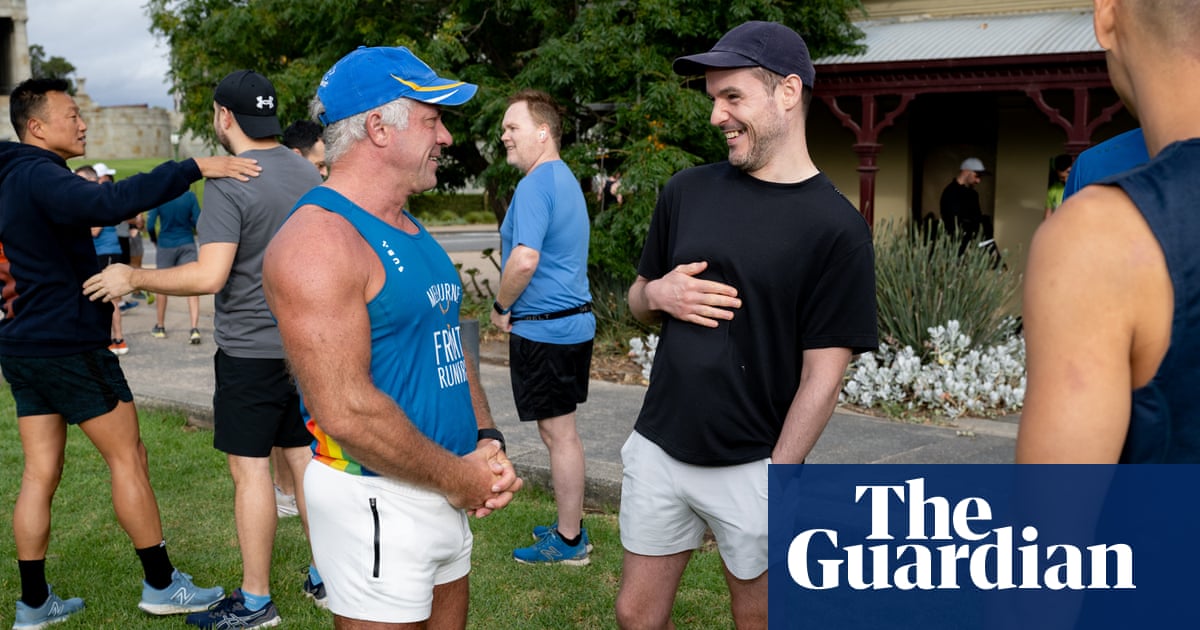Gay bars have traditionally been the most visible queer-inclusive spaces in Australia for LGBTQ+ people to gather. But with dim lighting, loud music and a focus on alcohol, they aren’t always conducive to genuine connection – or welcoming to all. And with dating apps blamed for the closure of gay bars and a trend towards younger people drinking less, many LGBTQ+ Australians are finding community through sport.
“It’s so intimidating to go to a gay bar,” says Michael Pereira, 34. “People think you’re going to have this Sex and the City experience and suddenly meet your authentic friends … I couldn’t do that.”
Five years ago Pereira joined Frontrunners, an LGBTQ+ running club that organises a handful of meet ups a week across Melbourne. The group has proved transformative. “People at Frontrunners have quickly become my best friends. It’s the best thing I’ve ever done,” he says.
Melbourne Frontrunners has been meeting for more than two decades and there are similar chapters across Australia and around the world. “It’s all about a healthy lifestyle and creating connections and friendships,” says Malcolm Campbell, president of the Melbourne chapter.
The group organises social events and an awards night and attenders often grab coffee or breakfast after running sessions. “Some people prefer that part to the run!” says Campbell.
A growing number of sports and fitness clubs are catering to Australia’s LGBTQ+ community, offering hiking, squash, yoga and tennis. While building connections is a priority for many attenders, being able to play sport free of discrimination is a more basic draw for others.
It was discrimination in mainstream basketball leagues that motivated Stella Lesic to found Queer Sporting Alliance (QSA) in 2015. “The majority of participants [in mainstream leagues] are well intentioned, but it just takes one or two people to shatter the fragility of trans and gender-diverse participation,” Lesic says.
Now one of Australia’s largest LGBTQ+ inclusive sports clubs with 1,500 active members, QSA offers basketball, netball, futsal and rollerskating in cities across the country. Lesic says QSA prioritises fun over competitiveness: “We’re the George Costanza of sports – we do things the opposite way.”
The first QSA team was, by Lesic’s admission, terrible. “It didn’t matter to us whether anyone could play well … We wanted the kid that got picked last at school to be in our team,” they say.
VicHealth research reveals LGBTQ+ people in Australia are less likely to participate in organised sports, with trans and non-binary individuals significantly underrepresented. Many are deterred by past experiences of discrimination, particularly at school – more than half of LGBTQ+ young people say they have witnessed discrimination in a sports setting.
Michael Wright, who helps run queer climbing club ClimbingQTs in Sydney, says he had a “complicated” relationship with sports at school. He now organises indoor and outdoor climbing events as well as multi-day excursions around the country.
“We’re building queer joy,” he says.
As with QSA, ClimbingQTs has a focus on trans inclusion (a spin-off TransQTs group meets regularly), and last month it held a session for deaf and hard of hearing climbers. Wright says visible representations of happiness and inclusion are important to the LGBTQ+ community, which has higher instances of poor mental health.
“It’s really hard to be what you can’t see,” he says.
Beau Newell, of LGBTQ+ sports inclusion organisation Pride in Sport, says although there has been progress towards inclusion in mainstream sport over the past decade, there is often an “illusion of inclusion” among sports leaders.
“CEOs might believe they’re inclusive because they’ve had no complaints, or they might believe it’s a safe environment because there’s a gay man on the board or the women’s team is full of lesbians, but that’s laughable,” Newell says.
“That’s kind of the mentality that a lot of people still have in this environment, and so, if anything, that just reinforces the critical need for us to do more education.”
For older LGBTQ+ Australians, the rise of inclusive sports clubs is bittersweet. Alastair Richards, who joined Frontrunners more than 20 years ago and is now in his 60s, says: “I wish this existed in my 20s. I definitely would’ve joined [then] – although it does start at 8.30am!”
With anti-trans rhetoric coming out of Trump’s White House, including a ban on trans athletes from participating in women’s sports, many in Australia fear a ripple effect, particularly in an election year. “It feels like standing on a beach waiting for a tsunami to hit,” says Lesic.
Thanks to the work of many sports leaders, Newell believes Australia is in a better position than the US, but stresses the need for “active allies” in the sporting community and society at large. “We actually need people to step up … if you hear a homophobic, biphobic or transphobic slur, joke or some sort of innuendo, call that out,” Newell says.
Ten years after founding QSA, Lesic continues to play basketball. But has their game improved?
“I’m still terrible,” they laugh. “My knees are made of dust and hope, but I’m having fun and that’s what’s important.”










